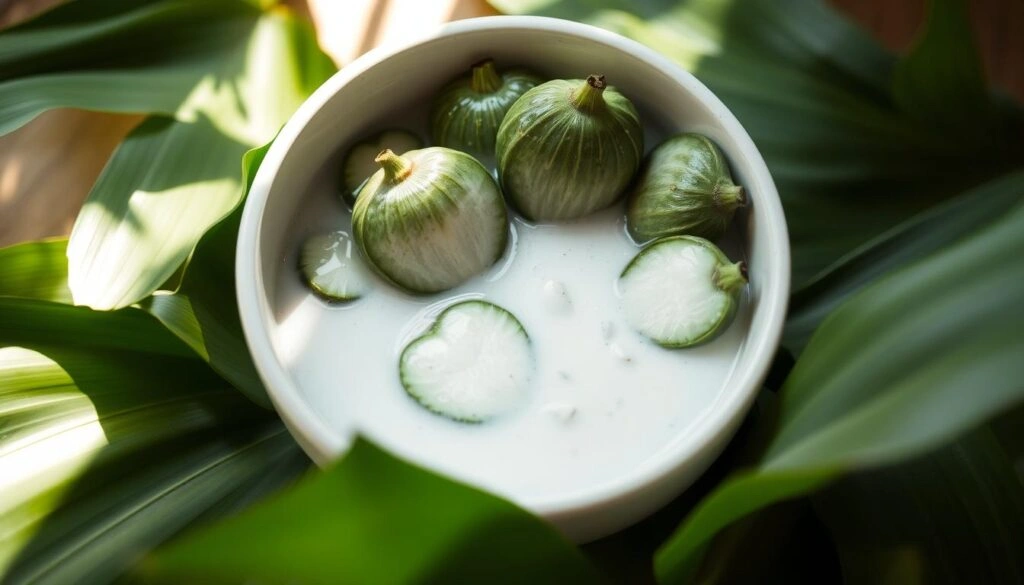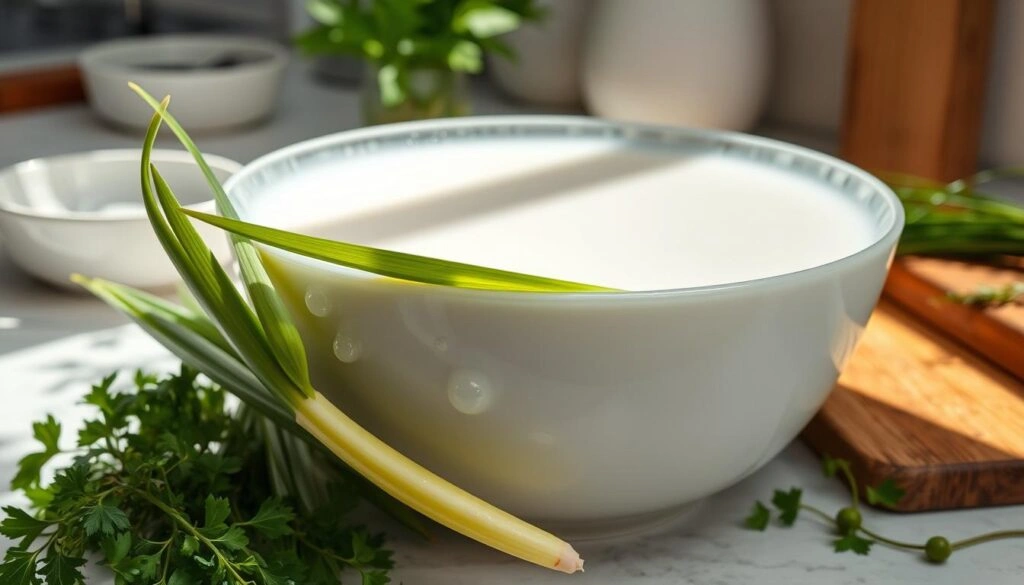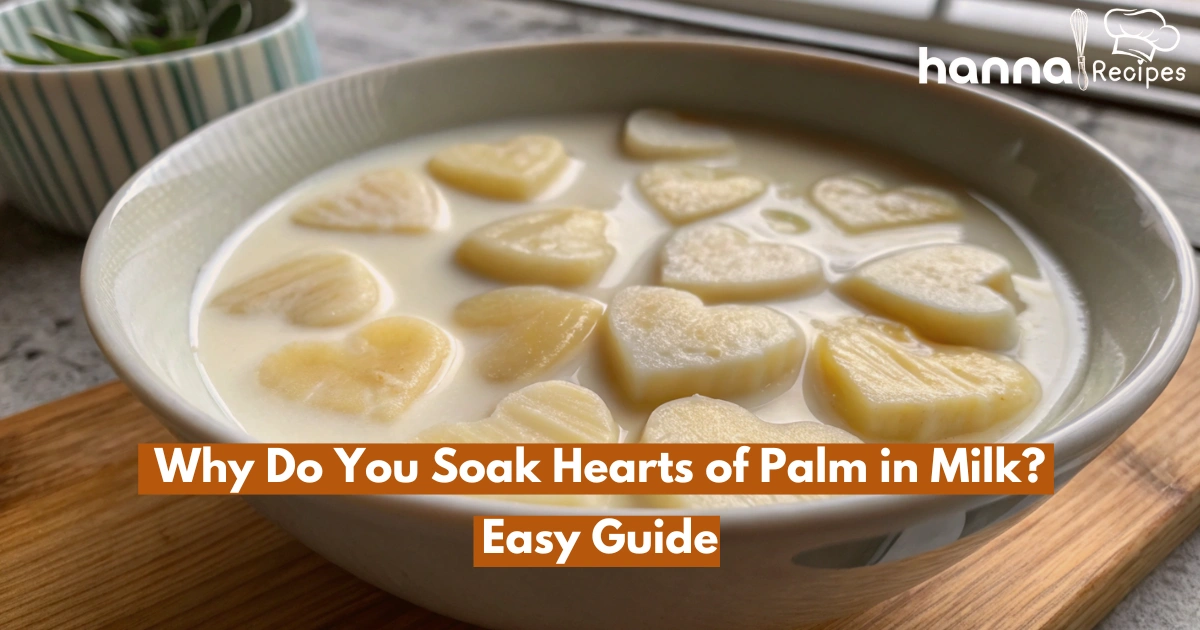Hearts of palm are a tasty and healthy addition to many dishes. But, many wonder why they need to soak in milk before cooking. This guide will explain why and show you how to soak them perfectly.

Key Takeaways
- Soaking hearts of palm in milk helps remove bitterness and improve their texture.
- Milk contains compounds that interact with the natural compounds in hearts of palm, resulting in a more palatable and tender end product.
- Understanding the science behind milk-soaking can help you achieve the best possible results when preparing this versatile ingredient.
- Following a simple step-by-step process can ensure your hearts of palm are perfectly prepared every time.
- Exploring alternative soaking methods and recipes can help you experiment with different flavors and textures.
Understanding Hearts of Palm: A Culinary Introduction
Hearts of palm are a tasty and flexible ingredient in cooking. They come from the center of certain palm trees. These tender, crunchy bits have a special taste and can be used in many dishes.
What Are Hearts of Palm?
Hearts of palm are the soft, white centers of palm trees like the Peach Palm and Cabbage Palm. To get them, the tough outer leaves are removed. This leaves the tender, white core, which is loved for its softness and mild sweetness.
Nutritional Benefits and Uses
- Hearts of palm are low in calories and full of fiber, making them a healthy choice.
- They also have important vitamins and minerals like vitamin C, potassium, and magnesium.
- They can be used in many ways, from salads and stir-fries to dips, sushi, and desserts. Their flexibility makes them great for many recipes.
Fresh vs. Canned Hearts of Palm
Fresh hearts of palm taste better and are firmer. But canned hearts of palm are easy to find and use. They are already cooked and ready to go, perfect for those in a hurry. Choose high-quality canned hearts of palm to get the best taste and texture.

Whether you use fresh or canned hearts of palm, they can make any dish better. Try them in your hearts of palm recipe to see how versatile they are.
Why Do You Soak Hearts of Palm in Milk?
Soaking hearts of palm in milk is a common practice in cooking. It makes the ingredient taste better, feel softer, and look more appealing. Learning why we do this can help you get the most out of hearts of palm in your dishes.
One main reason is to neutralize their natural bitterness. Hearts of palm can taste a bit bitter because of certain compounds. Soaking them in milk reduces this bitterness, making them taste milder and more enjoyable.
The milk bath also makes the hearts of palm tender. The milk’s lactic acid and enzymes soften the tough fibers. This is especially good for older or tougher hearts of palm.
Also, the milk-soaking process makes the hearts of palm look better. It brightens their color and makes them more vibrant. This makes your dishes more attractive to look at.
“Soaking hearts of palm in milk is a simple yet effective way to unlock their full flavor and texture potential.”
Knowing why we soak hearts of palm in milk helps us improve our cooking. It lets us get the best results when using hearts of palm in our recipes.

The Science Behind Milk-Soaking Vegetables
Soaking vegetables in milk is a cooking trick that makes them taste better and feel softer. But what’s really going on? Let’s explore the science behind this technique.
Chemical Reactions During Soaking
When you soak vegetables in milk, many chemical reactions happen. The acids and enzymes in milk work with the vegetable’s starches and proteins. This breaks them down and releases sugars, making the vegetables tender and sweet.
Milk Properties That Affect Taste
The unique composition of milk impacts the taste when you soak hearts of palm in milk. The fat and protein in the milk contribute to a creamy and rich texture, while the lactose adds a subtle sweetness. Additionally, the milk’s pH level helps balance the vegetable’s acidity, enhancing the overall flavor when you soak hearts of palm in milk.
Duration and Temperature Guidelines
- Soaking time: Soak your vegetables in milk for 30 minutes to 1 hour. This time lets the reactions happen without making the vegetables too soft.
- Soaking temperature: The best temperature for soaking is between 40°F and 60°F (4°C to 15°C). This keeps the vegetables intact while the milk works its magic.
Understanding the science of milk-soaking lets you bring out the best in your vegetables. You’ll make dishes that taste great and look good too.
“Milk-soaking is a simple but powerful technique that can transform the way you prepare and enjoy vegetables.”
Benefits of Soaking Hearts of Palm
Soaking hearts of palm in milk offers many culinary benefits. It’s a key technique for this versatile vegetable. By understanding the science, you can unlock its full potential and improve your cooking.
Removing Bitterness
Soaking hearts of palm in milk removes bitterness. The milk’s natural properties balance out the vegetable’s inherent bitterness. This makes the hearts of palm more enjoyable to eat.
Tenderizing Hearts of Palm
The milk-soaking process also tenderizes the hearts of palm. This is great for older or tougher specimens. The soaking breaks down fibers, making the vegetable more delicate and easier to work with.
Enhancing Flavor
Soaking hearts of palm in milk also enhances their flavor. The milk’s creaminess and lactic acid bring out the vegetable’s natural sweetness and earthy notes. This creates a more balanced and harmonious taste.
| Benefit | Description |
|---|---|
| Removing Bitterness | Milk’s natural properties help neutralize and balance the inherent bitterness of hearts of palm. |
| Tenderizing Hearts of Palm | The soaking process can break down fibers, creating a more delicate texture and making the vegetable easier to work with. |
| Enhancing Flavor | The milk’s creaminess and lactic acid can accentuate the natural sweetness and earthy notes of hearts of palm. |
Soaking hearts of palm in milk can change how you use and enjoy this versatile ingredient. It helps remove bitterness, tenderize the texture, and enhance flavor. This simple technique can take your hearts of palm dishes to new heights.
Step-by-Step Guide to Milk-Soaking Process
Preparing hearts of palm is a fun cooking adventure. The milk-soaking step is key to bringing out their flavor and texture. Just follow a few easy steps.
Preparation Methods
First, prepare the hearts of palm. Rinse them under cold water to get rid of dirt. Then, cut off the tough ends with a sharp knife. Cut them into lengths or slices as you like for your recipe.
Required Tools and Ingredients
To soak hearts of palm in milk, you need a few things:
- A bowl or container big enough for the hearts of palm
- Milk (you can use cow’s milk, almond milk, or any other non-dairy milk)
- A fridge to keep everything cold
Best Practices for Optimal Results
To get the best results from milk-soaked hearts of palm, keep these tips in mind:
- Use fresh, high-quality hearts of palm for the best taste and texture.
- Make sure the hearts of palm are fully covered in milk.
- Keep the soaked hearts of palm in the fridge for at least 30 minutes, or even longer, to let the flavors meld.
- Drain the hearts of palm before using them in your recipe.
By following these steps, you’ll enjoy delicious, flavorful milk-soaked hearts of palm.
Common Mistakes to Avoid When Preparing Hearts of Palm
Preparing hearts of palm can be a delightful culinary experience, but avoiding certain mistakes is essential to ensure your dish turns out perfectly. Here are the common errors and how to avoid them.
1. Inadequate Soaking
One big mistake is not soaking the hearts of palm properly before cooking. Skipping this step can make the texture tough and the taste bitter. Always soak the palmito in milk or a milk-based solution for the right amount of time.
2. Over-Soaking
Avoid over-soaking: Leaving the hearts of palm in the soaking liquid for too long can result in a mushy, undesirable texture. Stick to the recommended soaking time to prevent this.
3. Improper Temperature Control
Ensure the soaking liquid is at the recommended temperature range, as this can significantly impact the effectiveness of the soaking process. Maintaining the right temperature helps achieve the best results.
4. Inadequate Draining and Drying
Thoroughly draining and drying the soaked hearts of palm before cooking is essential. Excess moisture can affect the final dish, making it soggy or watery. Proper draining and drying help maintain the texture.
5. Overcooking the Hearts of Palm
Another common mistake is overcooking the hearts of palm. This delicate ingredient can quickly become tough and stringy if subjected to prolonged heat. Keep a close eye on the cooking time and use gentle, low-heat methods to preserve their tender, succulent texture.
| Mistake | Impact | Solution |
|---|---|---|
| Inadequate soaking | Tough, fibrous texture and bitter taste | Follow recommended soaking guidelines |
| Over-soaking | Mushy, undesirable texture | Avoid leaving hearts of palm in soaking liquid for too long |
| Improper temperature control | Reduced effectiveness of the soaking process | Maintain soaking liquid at the recommended temperature |
| Inadequate draining and drying | Excess moisture affecting the final dish | Thoroughly drain and pat dry the soaked hearts of palm |
| Overcooking | Tough, stringy texture | Use gentle, low-heat cooking methods and monitor the time |
By avoiding these common pitfalls and following best practices for preparing hearts of palm, you can unlock the true flavor and texture of this versatile ingredient. With a little attention to detail, you’ll be well on your way to creating delicious dishes that will impress your family and friends.
Alternative Soaking Methods and Solutions
Soaking hearts of palm in milk is popular, but not the only way. Try these other methods to find what works best for you.
Different Liquid Options
You can soak hearts of palm in many liquids for different tastes and textures. Use vegetable or chicken broth, vinegar, lemon juice, or water with seasonings. Mix and match to create the perfect heart of palm marinade or palmito cooking tips.
Marination Techniques
- For a stronger flavor, marinate hearts of palm for hours or overnight.
- Add herbs, spices, or aromatics to your marinade for more depth.
- Massage the hearts of palm in the marinade for even flavor.
Time-Saving Tips
Need to hurry? Here are quick tips. Use warm or hot liquid to soak faster. Slice hearts of palm thinly for quicker flavor absorption. With these tips, you can make tasty heart of palm marinade or palmito cooking tips quickly.
“Soaking hearts of palm in a flavorful liquid can transform their texture and taste, opening up a world of culinary possibilities.”
Delicious Recipes Using Milk-Soaked Hearts of Palm
Explore the versatility of milk-soaked hearts of palm in these tasty recipes. They work well in everything from cool salads to rich main dishes. They bring a special texture and taste to your cooking.
Creamy Hearts of Palm Salad
Begin with a zesty hearts of palm salad. Mix milk-soaked hearts of palm with crisp lettuce, fresh tomatoes, and a tangy dressing. It’s a refreshing start to your meal.
Grilled Hearts of Palm Skewers
Try grilled hearts of palm skewers for a tasty appetizer. Thread the hearts of palm on skewers, brush with a tasty marinade, and grill until done. Enjoy them with your favorite sauce.
Hearts of Palm Pasta Primavera
Make your pasta dish special with milk-soaked hearts of palm. Mix the hearts of palm with fresh veggies, pasta, and a creamy sauce. It’s a vibrant and fulfilling main course.
| Recipe | Ingredients | Preparation Time |
|---|---|---|
| Creamy Hearts of Palm Salad | Milk-soaked hearts of palm, lettuce, tomatoes, vinaigrette | 15 minutes |
| Grilled Hearts of Palm Skewers | Milk-soaked hearts of palm, marinade, skewers | 30 minutes |
| Hearts of Palm Pasta Primavera | Milk-soaked hearts of palm, pasta, vegetables, creamy sauce | 45 minutes |
Enhance your cooking skills with these delicious recipes using hearts of palm. Discover how this versatile ingredient can transform your favorite dishes with its unique flavors and textures.
FAQ
Why do you soak hearts of palm in milk?
Soaking hearts of palm in milk makes them taste better. It also makes them softer. The milk breaks down tough fibers and softens any bitter taste.
How do you prepare canned hearts of palm?
For canned hearts of palm, soak them in milk for 30 minutes to an hour. This step removes any tinny taste from the can. It also makes them even softer.
What are the benefits of soaking hearts of palm in milk?
Soaking hearts of palm in milk has many advantages. It: – Removes bitterness and astringency – Makes the texture softer – Enhances the flavor – Makes the vegetable more versatile in cooking
Conclusion
Soaking hearts of palm in milk is a simple trick that makes them taste better and feel softer. It’s all about understanding the science behind it. This way, you can make amazing dishes that everyone will love.
If you’re new to cooking or already a pro, we hope you found this guide helpful. It should give you the confidence to prepare hearts of palm easily. Remember, the secret to great taste and texture is in the milk-soaking method. Follow the tips in this article for the best results.
Exploring the world of hearts of palm is exciting. Try out different recipes and techniques. See how versatile this ingredient is and let your creativity shine. Enjoy your cooking adventures!


1 thought on “Why Do You Soak Hearts of Palm in Milk? Easy Guide”